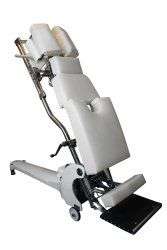
Forceful spinal manipulation is not always necessary to treat conditions of the lower back, mid-back and neck. Gentle chiropractic treatment, such as drop table techniques, involves less powerful spinal maneuvering and slower, low-velocity movements that allow the affected joint to stay within its passive range of motion.
How Does the Drop Table Technique Work?
Also known as the Thompson technique, the “drop” approach uses a special chiropractic table. The table used has segments that can be lifted up and then dropped when a thrust is applied by the chiropractor. The drop allows gravity to assist and work in combination with the manual adjustment, and all of this provides a lighter adjustment than that which comes with some other chiropractic techniques, such as those that involve twisting positions.
To further clarify, the table has various sections that are raised between 1 to 2 inches relative to the rest of the patient’s body. Once the section of the table is lifted, it is fastened in place and the stiffness of the table is altered based on the patient’s body weight. When the chiropractor applies a gentle thrust to the area needing adjustment, the table releases and drops down, causing that segment of the body to fall too. The drop table comes to a rest, but the patient’s body momentum continues for a short period. This momentum is equally as critical to the drop table technique as the thrust and dropping of the table are, because it aids in alignment.
What to Expect After a Drop Table Technique
The number of sessions needed depends on the type of condition the patient has and its severity. However, in general, the patient should have better range of motion and less pain with each treatment.
To learn more about the drop table technique and how it can help, contact your chiropractor.
